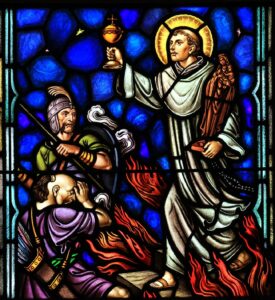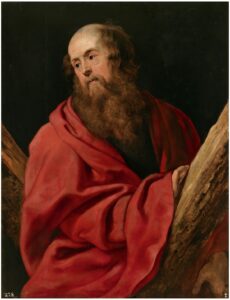We wind up another full week of Lent Madness action with Hyacinth squaring off against Andrew the Fisherman for a shot at the Elate Eight.
Yesterday, Albert Schweitzer removed any doubts as he defeated Thomas the Apostle 60% to 40%.
By the way, if you're looking to refresh your memory by re-reading the first round write-ups, just go to the bracket tab, and scroll down. Underneath the bracket you'll find links to all the previous battles.
We hope everyone has a full and faithful weekend, and we'll see you bright and early Monday morning as Kassia faces Joseph of Arimathea.
Vote now!
Hyacinth
 Accounts about St. Hyacinth tell of his life of goodness and service from his very birth. From his childhood of nobility, he was educated by teachers who his parents ensured would protect his innocent and loving disposition until he entered the Dominican order as a preacher in the 13th century. He preached all along the Northern Countries, including Poland, Lithuania, Prussia, and Moravia.
Accounts about St. Hyacinth tell of his life of goodness and service from his very birth. From his childhood of nobility, he was educated by teachers who his parents ensured would protect his innocent and loving disposition until he entered the Dominican order as a preacher in the 13th century. He preached all along the Northern Countries, including Poland, Lithuania, Prussia, and Moravia.
Many miracles are attributed to Hyacinth, including one where he led villagers escaping a siege in Kiev. The frantic people, fearful (justifiably so) and fleeing the Tartar onslaught, followed Hyacinth to the great river Dnieper. The people became more frantic with their escape route seemingly blocked, yet Hyacinth calmly prayed, then invited the people to follow him. Understandably cautious, the people hesitated. Hyacinth stepped on the water and began to cross, leaving footprints in the water, but not sinking into the river. Everyone crossed the river – walking on the water and following the footprints of Hyacinth. Even now, legend holds that when the water is low, Hyacinth’s footprints remain on the water's surface.
Hyacinth’s miraculous relationship with rivers continued on a journey to Vicegrad to preach. When he reached a river, he could not find a bridge, a narrow place to cross, or even a boat willing to take him to the other side, as the water was high and dangerous. Hyacinth spread his cloak on the water and floated safely to the other side, then sent his cloak back to retrieve his companions, as well. The dry, prayerful party continued on to their destination and work of Christ.
For over forty years Hyacinth traveled to countries in northern Europe, preaching, establishing monasteries, and helping those in need. In 1257, he returned to the monastery he founded in Krakow. Although he himself was very ill, he insisted on celebrating Mass on the eve of the Feast of The Assumption. He prepared himself to celebrate, reciting the psalm of the day: "In thee, O Lord, have I hoped." Hyacinth celebrated the Feast, then collapsed at the Altar. He was anointed at the foot of the Altar where he lay, then died on the Feast Day of The Assumption.
For a man who is known for his preaching, we have no surviving sermons of his, no quotes, and no writings. His legacy is not in the words he preached, but the impact they had. His words of Good News inspired countless people to establish monasteries and convents for places of prayer, safety, and care. He reminds us today of the importance of preaching to share the Gospel with faith, humility, and passion.
Hyacinth was canonized some 300 years after his death, and was the seventh Dominican raised to sainthood. He is the only Polish saint whose statue is on Bernini’s colonnade surrounding St. Peter’s Square in Rome.
Andrew the Fisherman
 St. Andrew, as previously established, was a disciple of Jesus, before witnessing the resurrection, and going out to spread the gospel to the ends of the Earth. According to the Golden Legend, he welcomed his death with the words “Cross, sanctified by the body of Christ. Good Cross, long desired always, I loved you and wished to embrace you. Welcome me and bring me to my master.” Tradition alternately sends him to Russia, Turkey, Ukraine, Cyprus and Scotland, before his martyrdom. (Have fishing boat, will travel, evidently.)
St. Andrew, as previously established, was a disciple of Jesus, before witnessing the resurrection, and going out to spread the gospel to the ends of the Earth. According to the Golden Legend, he welcomed his death with the words “Cross, sanctified by the body of Christ. Good Cross, long desired always, I loved you and wished to embrace you. Welcome me and bring me to my master.” Tradition alternately sends him to Russia, Turkey, Ukraine, Cyprus and Scotland, before his martyrdom. (Have fishing boat, will travel, evidently.)
Even after death, St. Andrew’s relics also trekked all across Europe His skull was exhumed after Constantinople became Istanbul, and returned to Patras, but the rest of his body was sent to the Amalfi Coast for safekeeping (and a relaxing sea breeze) in 1208. The Archbishop of Amalfi gifted Scotland with a shoulder blade said to be Andrew’s in 1879, and Pope Paul VI presented further bits of him in 1969, which we can only imagine they were extremely excited about.
It should be noted that the Scottish themselves have their own tradition for where Andrew went on his post-mortality journey. According to them, a Greek monk named St. Rule (or Regulus) had a vision in the 6th century, commanding him to take Andrew to “the ends of the earth.” So he departed from Patras, where Andrew had been killed, and eventually landed at Fife, clutching Andrew’s kneecap, upper arm, three fingers and a tooth.
In 832, an outnumbered Pictish king prayed for help against his Angle foe, and saw a saltire in the clouds. He took this as a sign of divine favor, and promised to make Andrew the patron of Scotland if he won. This didn’t fully happen until 1320, but in the Declaration of Arbroath, which declared Scotland independent from England, Andrew was named the patron saint of Scotland as a thank-you. This story also inspired Scotland’s flag: the white saltire on the sky-blue background.
44 comments on “Hyacinth vs. Andrew the Fisherman”
For some strange reason, my Friday email did not arrive until 1:02 AM Saturday, so I missed a day of voting. I would have voted for Hyacinth.
A little book bought in a church in Romania asserts that Andrew lived in Dacia--now Romania-and preached there. This was long before Scotland, I guess.